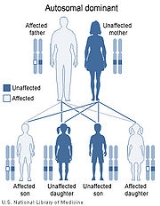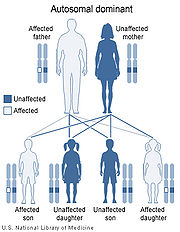
Holt-Oram syndrome
Encyclopedia
Holt–Oram syndrome is a disorder that affects bones in the arm
s and hand
s (the upper limbs) and may also cause heart
problems.
. Affected individuals may have additional bone abnormalities that can include a hypoplastic thumb or a thumb that looks like a finger, partial or complete absence of bones in the forearm, an underdeveloped bone of the upper arm, and abnormalities that affect the collar bone and shoulder blades. Bone abnormalities may affect each arm differently, and the left side can be affected more than the right side. In some cases, only one arm and/or hand is affected.
About 75 percent of individuals with Holt–Oram syndrome have heart problems. The most common problem is a defect in the muscular wall, or septum, that separates the right and left sides of the heart. Atrial septal defect
s (ASD) are caused by a hole in the septum between the left and right upper chambers of the heart (atria), and ventricular septal defect
s (VSD) are caused by a hole in the septum between the left and right lower chambers of the heart (ventricles). Sometimes people with Holt–Oram syndrome have cardiac conduction disease, which is caused by abnormalities in the electrical system that coordinates contractions of the heart chambers. Cardiac conduction disease can lead to problems such as a slow heart rate (bradycardia
) or a rapid and ineffective contraction of the heart muscles (fibrillation
). Cardiac conduction disease can occur along with other heart defects (such as septal defects) or as the only heart problem in people with Holt–Oram syndrome.
 Mutations in the TBX5 gene cause Holt–Oram syndrome. The TBX5 gene plays a role in the development of the heart and upper limbs before birth. In particular, this gene appears to be important for the process that divides the developing heart into four chambers (cardiac septation). The TBX5 gene also appears to play a critical role in regulating the development of bones in the arm and hand. Mutations in this gene probably disrupt the development of the heart and upper limbs, leading to the characteristic features of Holt–Oram syndrome.
Mutations in the TBX5 gene cause Holt–Oram syndrome. The TBX5 gene plays a role in the development of the heart and upper limbs before birth. In particular, this gene appears to be important for the process that divides the developing heart into four chambers (cardiac septation). The TBX5 gene also appears to play a critical role in regulating the development of bones in the arm and hand. Mutations in this gene probably disrupt the development of the heart and upper limbs, leading to the characteristic features of Holt–Oram syndrome.
Holt–Oram syndrome is considered an autosomal dominant disorder. This means the defective gene is located on an autosome
, and only one copy of the gene, inherited from a parent who has the disorder, is sufficient to cause the disorder.
Other cases of Holt–Oram syndrome are sporadic, and result from new mutations in the TBX5 gene that occur in people with no history of the disorder in their family. Holt–Oram syndrome is estimated to affect 1 in 100,000 individuals.
Arm
In human anatomy, the arm is the part of the upper limb between the shoulder and the elbow joints. In other animals, the term arm can also be used for analogous structures, such as one of the paired forelimbs of a four-legged animal or the arms of cephalopods...
s and hand
Hand
A hand is a prehensile, multi-fingered extremity located at the end of an arm or forelimb of primates such as humans, chimpanzees, monkeys, and lemurs...
s (the upper limbs) and may also cause heart
Heart
The heart is a myogenic muscular organ found in all animals with a circulatory system , that is responsible for pumping blood throughout the blood vessels by repeated, rhythmic contractions...
problems.
Presentation
All people with this disorder have at least one limb abnormality that affects bones in the wrist (carpal bones). Often, these wrist bone abnormalities can be detected only by X-rayX-ray
X-radiation is a form of electromagnetic radiation. X-rays have a wavelength in the range of 0.01 to 10 nanometers, corresponding to frequencies in the range 30 petahertz to 30 exahertz and energies in the range 120 eV to 120 keV. They are shorter in wavelength than UV rays and longer than gamma...
. Affected individuals may have additional bone abnormalities that can include a hypoplastic thumb or a thumb that looks like a finger, partial or complete absence of bones in the forearm, an underdeveloped bone of the upper arm, and abnormalities that affect the collar bone and shoulder blades. Bone abnormalities may affect each arm differently, and the left side can be affected more than the right side. In some cases, only one arm and/or hand is affected.
About 75 percent of individuals with Holt–Oram syndrome have heart problems. The most common problem is a defect in the muscular wall, or septum, that separates the right and left sides of the heart. Atrial septal defect
Atrial septal defect
Atrial septal defect is a form of congenital heart defect that enables blood flow between the left and right atria via the interatrial septum. The interatrial septum is the tissue that divides the right and left atria...
s (ASD) are caused by a hole in the septum between the left and right upper chambers of the heart (atria), and ventricular septal defect
Ventricular septal defect
A ventricular septal defect is a defect in the ventricular septum, the wall dividing the left and right ventricles of the heart.The ventricular septum consists of an inferior muscular and superior membranous portion and is extensively innervated with conducting cardiomyocytes.The membranous...
s (VSD) are caused by a hole in the septum between the left and right lower chambers of the heart (ventricles). Sometimes people with Holt–Oram syndrome have cardiac conduction disease, which is caused by abnormalities in the electrical system that coordinates contractions of the heart chambers. Cardiac conduction disease can lead to problems such as a slow heart rate (bradycardia
Bradycardia
Bradycardia , in the context of adult medicine, is the resting heart rate of under 60 beats per minute, though it is seldom symptomatic until the rate drops below 50 beat/min. It may cause cardiac arrest in some patients, because those with bradycardia may not be pumping enough oxygen to their heart...
) or a rapid and ineffective contraction of the heart muscles (fibrillation
Fibrillation
Fibrillation is the rapid, irregular, and unsynchronized contraction of muscle fibers. An important occurrence is with regards to the heart.-Cardiology:There are two major classes of cardiac fibrillation: atrial fibrillation and ventricular fibrillation....
). Cardiac conduction disease can occur along with other heart defects (such as septal defects) or as the only heart problem in people with Holt–Oram syndrome.
Genetics

Holt–Oram syndrome is considered an autosomal dominant disorder. This means the defective gene is located on an autosome
Autosome
An autosome is a chromosome that is not a sex chromosome, or allosome; that is to say, there is an equal number of copies of the chromosome in males and females. For example, in humans, there are 22 pairs of autosomes. In addition to autosomes, there are sex chromosomes, to be specific: X and Y...
, and only one copy of the gene, inherited from a parent who has the disorder, is sufficient to cause the disorder.
Other cases of Holt–Oram syndrome are sporadic, and result from new mutations in the TBX5 gene that occur in people with no history of the disorder in their family. Holt–Oram syndrome is estimated to affect 1 in 100,000 individuals.
Eponym
It is named for Mary Holt and Samuel Oram. In his account of the delineation of the syndrome, Oram mentioned that, as Holt was a lady, it seemed only proper to him that her name should appear as first author on their paper.External links
- GeneReview/NIH/UW entry on Holt-Oram Syndrome
- Holt-Oram syndrome: Encyclopedia of Genetic Disorders
- http://holt-oram.ning.com/ social network site for those affected by the condition

